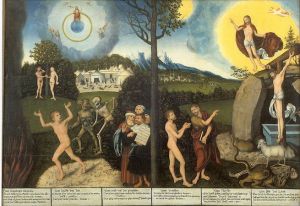The Protestant Reformation had a profound effect on the arts during the Northern Renaissance period. As reformers rebelled against the Catholic Church, they tried to distance themselves from the sacred art prominent within the Catholic Church.
The Protestant Reformation can be traced back to the Martin Luther’s writing of the ninety-five theses. These theses outlined how many of the Catholic Church practices were counter to the teachings in the Bible. The Catholic Church preached that man’s salvation could be promised by doing good deeds, which included purchasing sacred art to decorate Christian churches. Luther, however, taught that man’s salvation was through faith alone, not good deeds or indulgences.
As many of the Reformers studied the Bible, they noticed that the Catholic Church practices did not match up to what they were reading. They soon saw sacred art within the church as a form of idol worship and destroyed most Christian art during iconoclastic riots.
While Luther is noted as being the “father of the Reformation”, Lucas Cranach the Elder could be noted as the “illustrator of the Reformation.” Luther used the printing press and paintings to advertise his teachings and publicize his clashes with the Catholic Church. Cranach was the creative means to broadcast the message.
Cranach was trained in Vienna during the Renaissance. After a court appointment by Fredrick the Wise to be the Saxon court painter, his work moved from scared and mythical pieces to more of portrait sittings. During his time at the Saxony court in Wittenberg, he because acquainted with Martin Luther who taught at Wittenberg University. As a printmaker, his woodcarvings were used to illustrate booklets and pamphlets produced by Luther. Cranach’s paintings helped to spread the message. The most influential image that depicts Luther’s teaching of faith-based salvation is, The Law and The Gospel (or Law and Grace.) It was produced as both a woodcut and a panel painting. The image demonstrates Luther’s belief of receiving salvation through grace and the word, as opposed to the Catholic Church doctrine of following Biblical law. The right side of the painting shows man receiving salvation through God’s grace, while man is driven from God by not being able to uphold Biblical law on the left side of the painting.

My Perspective on The Law and the Gospel
I am moved by this piece mainly for the message that it illustrates – true salvation is through God’s grace. Cranach’s attention to minute details keeps me riveted. The face hidden in the burning hell in the lower left corner. The feeling of peace in the town on the right half, as opposed to the destruction of war on the left. The symbolism of the lamb on top of the lizard and skeleton. As most artist of this period, they would add prominent people of the time to their pieces, most often the patron who commissioned the art. Cranach was no different. On the left half, standing with Moses and the Ten Commandments are Protestant Reformers, Martin Luther at the top of the group. As you read the altarpiece left to right, you see that Luther does not say that we should throw out the Old Testament, but use it as a guide toward God’s grace.
Works Cited
Zucker, Steven and Harris,Beth. “Reformation and Counter-Reformation”. Renaissance and Reformation in Europe. https://www.khanacademy.org/humanities/renaissance-reformation/protestant-reformation1/a/the-protestant-reformation. Accessed January 28, 2016.
Noble,Bonnie. “Cranach, Law and Gospel(Law and Grace)”. Renaissance and Reformation in Europe. https://www.khanacademy.org/humanities/renaissance-reformation/protestant-reformation1/a/cranach-law-and-gospel-law-and-grace. Accessed January 28, 1016.
Condry, David. Illustrator of the Reformation: Lucas Cranach and the Lutheran Cause. April 22, 2013. https://www.academia.edu/6387760/Illustrator_of_the_Reformation_Lucas_Cranach_and_the_Lutheran_Cause. Accessed January 28, 2016.
Unknown. “Lucas Cranach the Elder.” Reformation 500. http://reformation500.csl.edu/bio/lucas-cranach-the-elder/. Accessed January 28, 2016.
Unknown. “Law and Grace”. http://www.bibleodyssey.org/en/tools/image-gallery/c/cranach_lawgrace.aspx Accessed January 28, 2016.
Cranach’s style is so singular. The minute you see one, you can recognize it as his work. I was so fortunate to see an exhibit of his work while I was visiting the Galleria Borghese in Rome in 2010.
LikeLike
Very interesting post. I didn’t know much about the Protestant Reformation and I found your blog to be very informative. I read a little bit a Cranach (on Wikipedia) and it sounds like he was very much influenced by his patrons, one of them being Martin Luther. I was also wondering if you could expand on symbolism of the lamb on top of the lizard and the skeleton? I’m assuming this has something to do with the Protestant religion? I personally don’t find the work that aesthetically pleasing, but I do enjoy the constant of dark and light or good vs. evil
https://en.wikipedia.org/wiki/Lucas_Cranach_the_Elder#Early_life
LikeLike
Geogirlart, the lamb is representative of Jesus Christ within the Christian faith. The lizard depicts (original) sin and the skeleton depicts death. With the lamb standing on the lizard and skeleton, it represents that Jesus conquers death and sin.
LikeLike